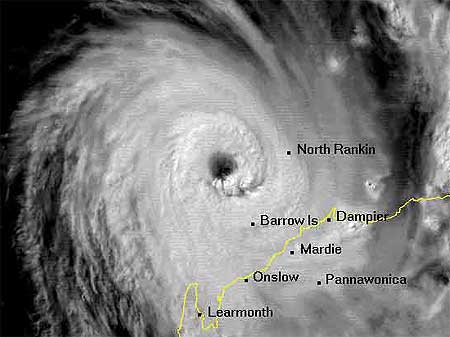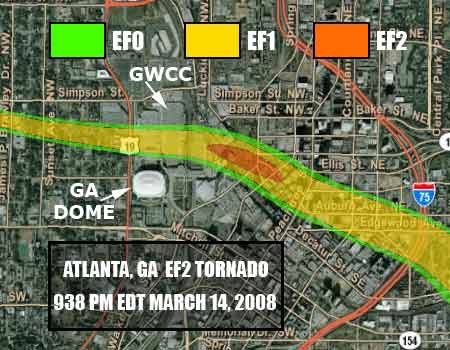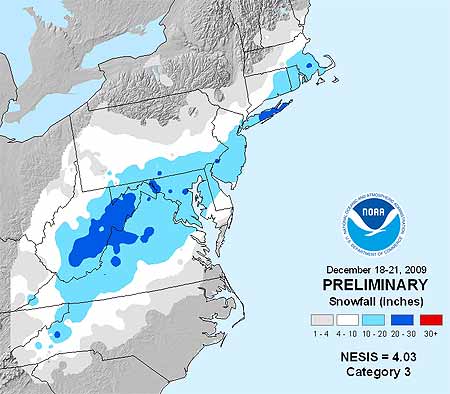Frank Marks, Director of NOAA’s Hurricane Research Division, believes in serendipity. He jumped at an opportunity to conduct radar research on tropical cyclones for the Division some 30 years ago following a field project in western tropical Africa. There, in Dakar, he had serendipitously met his mentor, Verner E. Suomi, and hasn’t looked back since.
On Wednesday at the Awards Banquet (7 p.m. in the Washington State Convention Center, Hall 6A-B-C-D), the AMS will present Dr. Marks with the Verner E. Suomi Award for creative use of airborne Doppler radar and other technologies to advance the understanding of the dynamics of tropical cyclones. The AMS grants this award annually to individuals in recognition of highly significant technological achievement in the atmospheric or related oceanic and hydrologic sciences.
The Front page sat down with Marks to learn more about him and his career-spanning research. While wrapping up the interview, which you can watch below, he shared this perspective: “When an opportunity presents itself, you take it. That’s how I’ve lived my life.”
 Chris
Chris
Teaching Excellence: Mentor Realizes Dream Award
Henry E. Fuelberg, a professor of meteorology with Florida State University, is this year’s recipient of the AMS award for Teaching Excellence. The Front Page sat down with Dr. Fuelberg to learn more about him, his research program at FSU, and the devotion he has to seeing his team of students excel in their budding careers as meteorologists. He noted after the interview, available below, that of all the prestigious honors the AMS bestows, “this was the award most important to me.”
Fuelberg will receive his award at the AMS Awards Banquet Wednesday at 7 p.m. in the Washington State Convention Center, Halls 6A-B-C-D.
The Unconventional Convention–A 'Curse' Put to Rest

Like snowflakes blowing in the winds of a blizzard, an ugly rumor had swirled through AMS Annual Meetings past. People…meteorologists, no less (you know who you are!), began saying that the convergence of so many meteorologists each year led to “bad” and sometimes “dangerous” weather in the host city.
The evidence was accumulating: flooding rain, mudslides, and severe storms in 2005 in perpetually sunny San Diego; crippling ice storms in 1978 and 2007 during the only two AMS visits to San Antonio; tornadoes in 1993 near Anaheim, California, while AMS huddled at Disneyland; and Mardi Gras parade in blasting winds and shivering chill during the 2006 Annual in New Orleans. We do not care to cite more.
On Saturday, however, with sunshine sneaking into the late January Seattle forecast, it seemed to be the right time to dispel this myth. Following the unremarkable weather a year ago in Atlanta, this week’s forecast is poised to further unstack the evidence against our maligned meteorological influences. The familiar light rain set to kick off the new week is supposed to gradually end and, as clouds thin and break up, full-fledged sunshine is expected beginning Tuesday and lasting the rest of the week. High temperatures are forecast to be near 60 degrees in the middle of the week, more than a dozen degrees above average.
Wow! Unusual, isn’t it? How about that—we don’t bring bad weather with us every year after all. Cliff Mass of the University of Washington seems emboldened enough to explain on his blog that this “dirty ridge” over the region is
This benign weather report is clearly due to the presence of thousands of meteorologists in town for the annual meeting of the American Meteorological Society. The weather gods know not to cross us.
We’re not as confident as all that…not yet. Maybe the real stigma we can’t shake is the onset of unconventional weather–both good and not so good.
So, to all those mayors and city commissioners out there scheduled to host AMS Annual Meetings in the years to come, there’s no use in fretting. Maybe…just maybe…that wild winter weather you wish would abate will do so when the AMS comes to your town.
Video Whirls Thru Hyperactive Hurricane Season
NOAA recently posted its annual video compilation of the entire 2010 Atlantic hurricane season, and it’s impressive. Crammed into just under 5 fast-paced minutes, you’ll see 6 months of tropical and mid-latitude weather seamlessly wax, wane, dip, and swirl across your computer screen. It stars this year’s 19 named storms, from Alex to Tomas, and even a few Eastern Pacific whirls. Can you spot them all? (Occasional names following the organized cloud clusters will help you.)
NOAA’s Environmental Visualization Lab produced the video. You can view the larger version on YouTube (where the tiny storm names are easier to see).
An historical overview of the 2010 season is available from NOAA here.
For more detail, the National Hurricane Center has archived the season’s tropical cyclone advisories, and will eventually post summary reports of all of the year’s named hurricanes and tropical storms. New this year, you can view the individual storm tracks in Google Earth; from the summary reports page, click on the KMZ link after each storm name to launch Google Earth, and then interact by clicking a storm position to get specific advisory information. (What’s that you say? You don’t have Google Earth?? Well, just download it!)
Time to Tone Down Hurricane Season Prognostications?
With a third of the Atlantic hurricane season over and just three storms named (albeit accompanied by one tropical depression), should hurricane season prognosticators consider backing down from their early season forecasts of a wild season? And we’re not just talking about one or two Punxatawny Phils here — this year realized eight separate forecasts of named storms and hurricanes for the six-month season, which began June 1. Predictions of the number of named storms ranged from 17 to a lofty 23 — far above the average of 11 named storms realized over the last 60 years.

The real meat of hurricane season is from mid August through mid October, when about 90% of a season’s storms form. Based on the May and June forecasts, that would equate to about 15-21 tropical storms and hurricanes — still a substantially busy season. But the chatter has begun on the blogs (2nd topic on this page) and in the online and mainstream news that this year will not be like 2005. By this point in that season the Atlantic had already seen eight named storms, including two major hurricanes. The 2005 season went on to realize 27 named storms, including Category 5 Hurricanes Katrina, Rita, and Wilma, and one unnamed storm added to the tally in the post-season.
So what drove the early season forecasts? And why might they need to be lowered? As in 2005, sea surface temperatures (SSTs) across the Atlantic basin have been well above average since spring. In fact, record warm SSTs have dominated the main tropical cyclone development region—from 10°N to 20°N between the coast of Africa and Central America (20°W – 80°W)—for five consecutive months (see the 2nd topic entry on this page). Combine that with lower-than-normal surface pressure basin wide and the fact that El Niño was not only ending but appeared poised to transition to La Niña conditions (which it did) in the tropical Pacific, both of which are factors that can lead to more than the usual number of storms, and forecasters had almost no choice but to set their sights rather high. Conditions appeared very favorable for a quick start to a long and busy season, not unlike 2005.
Problem is, that hasn’t happened. The tropical cyclones that have developed this year have struggled. Despite all the favorable features, it appears dry air and more importantly strong wind shear across the Caribbean and Gulf of Mexico in June and July have kept storms in check. Typically, the atmosphere over the Atlantic Basin moistens significantly starting in August as the westward-moving Saharan dust outbreaks wane. And seasonal wind shear also becomes more conducive for storm development by August. Still, the next four months would need to see the pace of tropical storm and hurricane formation come fast and furious to realize the forecasts. It could happen: in 1995, 16 tropical storms and hurricanes, including five major hurricanes, formed one after another after another from the last days of July through the end of October, leaving just 10 days in the three-month period free of any storms. But that kind of hurricane history isn’t likely to repeat itself. Even 2005 had more storm-free days in the same portion of the season.
So what will forecasters do? Time will tell as two of the leading forecast teams—NOAA and the Colorado State University Tropical Meteorology Project, led by Phil Klotzbach and William Gray—update their forecasts this week. (Check these links for their updated forecasts: CSU (Aug. 4) and NOAA (Aug. 5).
Update …
Largely Unchanged Forecasts Point to Busy Months Ahead
With their August updates, hurricane season forecasters have left their predictions generally intact. The CSU forecast (pdf file) remains the same with 18 named storms total, 10 hurricanes, and 5 major hurricanes. After increasing its forecast in July by one named storm that was likely to be a hurricane, Tropical Storm Risk (TSR), a private British forecasting company, is back to its early June forecast numbers, with its August update (pdf file) again calling for about 18 named storms, 10 hurricanes, and 4-5 major hurricanes projected. NOAA shaved down the upper range of its seasonal forecast numbers while keeping the lower end of the range intact for named storms and hurricanes, and narrowing the range of major hurricane expected. Its updated forecast is for 14-20 named storms, 8-12 hurricanes, and 4-6 major hurricanes, versus its June forecast of 14-23 storms, 8-14 hurricanes and 3-7 major hurricanes. Florida State University lowered its prediction by 2, from 17 to 15 named storms and from 10 to 8 hurricanes.
A Record Nearly Lost in the Wind
A lot of fanfare surrounded the announcement in January (including our post here) that Barrow Island, a Brooklyn-size spot of land 31 miles off Australia’s northwest coast, now holds the record for the strongest recorded surface wind gust. The new record–a howling 253 mph (408 kph) during the passage of Tropical Cyclone Olivia on April 10, 1996–seemed worthy of instant fame. So, like many weather enthusiasts, we wondered why it took more than a decade for this immense wind to be recognized. The answer seems as amazing as the wind gust.
“There isn’t anything sinister about the 14 years delay in the TC Olivia wind record,” writes Randy Cerveny, of Arizona State University, in e-mail correspondence. Cerveny is a member of the World Meteorological Organization (WMO) panel that scrutinized and accepted the gust as a new wind record. “The basic truth is, unfortunately, the record was simply overlooked.”
Cerveny, a professor of climate studies at Arizona State University, explains that the high wind gusts—there were five—were measured on instrumentation owned by the private consulting company RPS MetOcean. Australia’s Bureau of Meteorology (BOM) was notified about the gusts, but considered them suspect since they were extraordinarily high for a 145 mph tropical cyclone, and because the accuracy of the equipment used to measure the gusts was unknown. Meteorologists at RPS MetOcean coauthored a paper on TC Olivia in 1999 and presented their findings at the small Offshore Technology Conference in Houston that year. A companion presentation explained the physical mechanism that likely generated the extreme gusts as a mesovortex in Olivia’s well-formed eyewall. But, then, the observations “fell through the research cracks,” Cerveny stated.
The panel of scientists charged with determining global weather and climate extremes as part of the WMO’s Commission for Climatology (CCl) only began looking into the TC Olivia wind gusts after completing an evaluation of the “new” record tropical cyclone wind gust of 211 mph measured during 2008’s Hurricane Gustav in Pinar del Rio, Cuba. The panel reviewed numerous exceptional wind gusts recorded in Olivia on Barrow Island and concluded that five peak gusts, ranging from 186 mph to the peak of 253 mph were indeed accurate. The other gusts measured 229 mph, 233 mph, and 215 mph, lending credibility to the record wind. So, not only did Olivia usurp Mt. Washington’s record surface wind, but it also eclipsed the just-recognized maximum wind gust in a tropical cyclone that Gustav produced.
As Jeff Masters of the Weather Underground noted in his online blog, Olivia was an intense tropical cyclone with gusts that crossed the 200 mph threshold of an EF-5 tornado, making them capable of causing catastrophic damage. Indeed, Olivia significantly damaged the oil and gas facilities on Barrow Island and nearby land areas in the region, and did extensive damage to homes inland in Mardie and Pannawonica in Western Australia.
NCAR Appoints Roger Wakimoto Director
Roger M. Wakimoto, an associate director and senior scientist at the National Center for Atmospheric Research (NCAR) in Boulder, Colorado, and an elected Fellow of the AMS, has been named NCAR’s new director. He succeeds Eric J. Barron, who left NCAR this month to assume the presidency of Florida State University. Wakimoto will assume his new position on February 1.

“Roger is a world-class scientist and administrator with broad knowledge of both the atmospheric sciences and the university community that NCAR serves,” says Richard Anthes, president of the University Corporation for Atmospheric Research (UCAR), which manages NCAR for the National Science Foundation (NSF), and a past president of the AMS. “I am are very pleased to have him at the helm of NCAR.”
A geophysicist with expertise in tornadoes, thunderstorms, and other types of severe weather, Wakimoto has served since 2005 as director of NCAR’s Earth Observing Laboratory (EOL), which oversees instrument development and major field projects. He has most recently guided the development of a major workforce management plan for NCAR. Wakimoto came to NCAR after 22 years at the University of California, Los Angeles, where he was a professor of atmospheric sciences for more than a decade and also chaired the department.
“I am both excited and honored to take on the challenge of building on the organization’s expertise and leading it in new and potentially exciting directions,” Wakimoto says. “NCAR is in a strong position to help meet the nation’s growing demand for research into weather and climate change.”
At NCAR, Wakimoto oversaw a comprehensive survey of instrumentation to better serve atmospheric scientists, and he collaborated with researchers at other agencies in VORTEX2, the largest tornado field study ever conducted. His ties to the center date back to the late 1970s, when he participated in a field project as a graduate student to study wind shear, a potential threat to aircraft. He has also served on the UCAR Board of Trustees and was chair of the University Relations Committee.
Wakimoto has written or co-authored more than 100 peer-reviewed papers in meteorology and has taken part in a dozen major field projects in the United States and overseas. He has served on numerous committees, panels, and boards for the NSF, The National Academies, the AMS, and other organizations. He has won numerous awards and honors, including a scientific and technical achievement award from the Environmental Protection Agency for observations of air pollution, and the Meisinger Award from the AMS in recognition of his contributions to understanding mesoscale weather events.
Mt. Washington's World Record Wind Toppled
It stood for 62 years and helped earn New Hampshire’s 6,288-foot Mt. Washington the distinction of having the World’s Worst Weather. Yet, more than a decade ago, a little known tropical cyclone in the South Indian Ocean blew away Mt. Washington’s famous gust of 234 mph — the previous fastest wind ever measured on Earth outside of a tornado. According to the World Meteorological Organization (WMO), the record now belongs to Barrow Island, Australia, a spot of land 31 miles off that continent’s northwest coast that was blasted by Tropical Cyclone Olivia on April 10, 1996. Olivia delivered a record gust of 253 mph (408 kph).

A panel of scientists charged with determining global weather and climate extremes as part of the WMO’s Commission for Climatology (CCl) recently reviewed numerous exceptional wind gusts recorded on Barrow Island during Olivia. They concluded that five peak gusts, ranging from 186 mph to the peak of 253 mph were indeed accurate. The other gusts measured 229 mph, 233 mph, and 215 mph, lending credibility to the record wind. The scientists concluded that a mesovortex in Olivia’s well-defined eyewall was likely the cause of the extreme winds.
But the record wind went unnoticed for a decade before the panel happened upon the observations from Barrow Island. Already stunned by losing the record wind gust distinction, Mt. Washington Observatory Executive Director Scot Henley told the Associated Press he was shocked the record remained hidden so long.
“Somehow it fell through the cracks and the Australians didn’t think it was a big deal,” he stated. “We hear that, and it kinds of blows our minds.”
Well, it might not have been quite as simple as that, as Jeff Masters of Weather Underground reports in his blog. He writes that Australia’s Bureau of Meteorology (BOM) was notified about the gusts, but considered them suspect since they were extraordinarily high for a 145 mph tropical cyclone, and because the accuracy of the equipment used to measure the gusts was unknown. Even after a paper on the extreme wind was written in 1999, the data remained in wait another 10 years until someone with the BOM resurrected it and brought it to the attention of the CCl. Read more about why it took 14 years for the record wind to be recognized.
The CCl panel determined the instrument that measured the record wind was a “heavy duty three-cup Synchrotac anemometer,” its report states. It was located near the center of Barrow Island and positioned 33 feet (10 m) above ground level and 210 feet (64 m) above sea level in relatively open terrain. Guy wires stabilized the cyclone-rated Hills telescoping mounting tower, and the anemometer was found to be regularly inspected and calibrated.
According to Wikipedia, Barrow Island, which is slightly larger than Brooklyn, New York, was uninhabited until the 20th century. Oil was discovered there in commercial quantities in 1964 and subsequent drilling resulted in Barrow Island becoming Australia’s leading producer of petroleum and natural gas. The anemometer that measured the world’s new fastest surface wind is owned and maintained by Chevron.
A report of the record wind is posted on the Arizona State University Web site. It contains additional details of Olivia’s record event and names the report’s panel of experts within CCl.
Atlanta Tornado and Impacts: Weather 2009
In the evening of March 14, 2008, the Georgia World Congress Center where the 90th Annual Meeting of the AMS is taking place this year was hit by an EF2 tornado. The supercell thunderstorm that produced the tornado was unexpected that day, with an outbreak of tornadoes forecast for, and subsequently realized, the next day.

The adjacent Omni Hotel as well as CNN Center and a number of nearby hotels and buildings suffered significant damage in the tornado. CNN Center alone lost more than 1600 windows, and windows are still missing in the tube-shaped Westin Peachtree Plaza tower.
CNN was not broadcasting live from Atlanta that night with programming instead coming from its New York and Washington offices. If the 24-hour network had been live from CNN Center, “It could have been a classic You Tube moment,” says Brandon Miller, a weather producer for CNN International, adding, with “us in the center of the tornado, anchors looking all around, fear on their faces … Fortunately, that didn’t happen.” Miller says CNN didn’t cover the tornado strike itself live, but “covered the heck out of the damage afterwords.”
While this tornado event won’t be presented as part of Impacts: Weather 2009 at the 2010 AMS Annual Meeting, a presentation during this Tuesday session will look at Tornado Effects on a Rural Hospital: Impacts of an EF-3 Tornado that struck Americus, Georgia in March 2007 (2:00 PM, January 19, 2010, B206). A presentation Wednesday morning (9:15 AM, B217) will look at lightning characteristics of the Georgia tornado outbreak the day after the 2008 Atlanta tornado. Its author commented that lightning characteristics of the tornadic storm that struck Atlanta the previous day might also be presented, if time allows.
Also, a poster to be presented Monday will investigate the relationship, if any, between Southeastern tornadoes and drought. A climatological analysis of antecedent drought and spring tornadic activity will be available for viewing during the poster session Observed and Projected Climate Change from 2:30 – 4:00 PM Monday, January 18.
December East Coast Snowstorm a Cat. 3
Memories of the pre-Christmas snowstorm that paralyzed travel across megalopolis in mid December might not be as fresh as the severe cold snap that kicked off the new year east of the Rockies. But the storm, which dumped 1-2 feet of snow on the Mid-Atlantic, earned a Category 3 ranking on the Northeast Snowstorm Impact Scale, known as NESIS, classifying it as a “major” winter storm.

NOAA’s NESIS ranks Northeast snowstorms on a five-tier scale ranging from Category 1 “Notable” to Category 5 “Extreme.” It characterizes the storms based on how much snow falls (must deposit at least 10 inches); the size of the area affected, and the population of the impacted area. Developed in 2004 by renowned winter weather experts Louis Uccelini and Paul Kocin, both with the National Centers for Environmental Prediction, catalogs snowstorms dating back to 1888.
“Last month’s storm was one of only five in the past decade that ranked Category 3 or higher,” says Kocin. The others: December, 2002 (Category 3); February, 2003 (Category 4); January, 2005 (Category 4); February, 2006 (Category 3), and February, 2007 (Category 3). Topping the NESIS scale—and the only winter storms rated Category 5—are the “Superstorm” on March, 1993 and the “Blizzard of ’96” in January, 1996. Last month’s snowstorm fell short of the higher NESIS rankings for several reasons, explains Uccelini.
“While snowfall from the December storm ranked in the top ten for Washington, Baltimore and Philadelphia, the storm only provided a glancing blow to the New York City and Boston metropolitan areas and overall affected a relatively small area. This led to it being classified as a Category 3,” he says.
Although NESIS is the only snowfall index being used operationally by NOAA, there are NESIS-like indices being developed for other parts of the nation. At the AMS Annual Meeting in Atlanta, a presentation by Michael F. Squires (Wednesday, 20 January, 2:00 PM, B211) will discuss the Development of regional snowfall indices.
Addtionally, David Robinson of Rutgers University will introduce a new climate data record of satellite-derived snow cover extent in his presentation Northern Hemisphere snow cover extent during the satellite era (Wednesday, 20 January, 10:30 AM, B218).